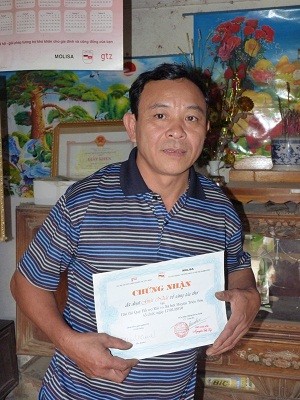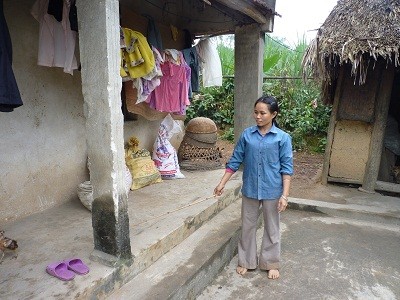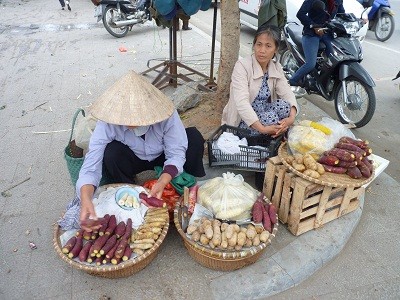Hello and welcome to the Sunday show, our biggest feature of the week on Voice of Vietnam Radio showcasing Vietnam’s traditional culture, hospitable people, beautiful landscapes and more. I’m…… I’ll be hosting the show today, and I hope you enjoy it.
In today’s show, we’ll introduce you to Social Risk Fund, a new approach to reducing poverty in the northern province of Thanh Hoa.
Ha Huu Chuyen is standing outside the family house on his farm in Trieu Thanh commune in Vietnam’s north central province of Thanh Hoa. Like many people in the area he lives off his pigs, chicken, and fish. He also has some land where he cultivates rice. His farm is self-sufficient. His family of five is not rich, but they get by, Ha Huu Chuyen says. That’s life here for a lot of people. And it works. Until a family member gets sick.
Sickness or even the death of a family member can plunge households into poverty in this area, where most families live off agriculture. Such tragedies often catch families here unprepared. High hospital fees in combination with one less person to help out on the farm –it’s a vicious cycle, which the community of Trieu Thanh has decided to break.
Farmer Ha Huu Chuyen is reciting a poem. He wrote it himself and was awarded the first prize in a competition with it. The idea behind the competition: spreading the word about the community’s Social Risk Fund. The fund is a new model of social protection which is being piloted in the area.
 |
| Chuyen won the first prize for his poem of the fund |
It’s a rocky drive from the farm to the offices of the local authorities. In the car with us is Nguyen Thi Nam. She’s the Social Risk Fund project officer of GTZ, the German technical corporation which helped implement the fund in Trieu Thanh. She says in remote areas like this, the government’s social welfare measures often don’t reach the people: “This community is far away from central hospitals and healthcare services. With money from the fund local people can pay their travelling costs to the hospitals. The government covers costs for medicine, treatment and patients’ stay in hospital, and the fund compensates relatives who take care of the patients while they’re in hospital. In a way you could say that the fund complements the government’s policies by facilitating access to public healthcare services.”
Between 30 and 40,000 Vietnamese Dong, roughly 2 US dollars – that’s how much a family has to pay a year to become a fund member, Nguyen Thi Nam explains. The exact amount depends on the number of people in the household. Should a family member get sick or have an accident, the household receives a total of 300,000 Dong out of the fund. If somebody dies, the relatives are given a lump sum of one million Dong. In addition to the money contributed by locals themselves, the fund is topped up with money from the communal authorities as well as from donors.
The equivalent of 2 US dollars doesn’t seem like a lot of money. But to many people here it is. Trieu Thanh is situated in a mountainous area. Driving on the rocky road we pass makeshift houses with sealed doors- people have left the community to look for jobs elsewhere in Vietnam.
Le Van Que is the president of the community’s people’s committee. Only 5,000 people are currently still living in Trieu Thanh, he says. Many have left: “Living conditions here are bad. The population is very poor. Last year’s figures showed that the average income was about 5.4 million VND – or 250 US dollars– per person per year. The local infrastructure is in a bad state, and the level of education is low. Weather conditions here are often unfavourable. We often have droughts and mudslides. That in turn leads to epidemics among both people and livestock.”
And so for many people here in Trieu Thanh life is a daily struggle. 33-year-old Cao Thi Hoai says she doesn’t always have the means to put money aside: “We don’t have much land for crops. Without a good education, we have to do manual work to earn a living. My husband is now working in the southern region and has not sent us any money for the past few months. I have to ask my neighbours for loans to buy food for my children.”
 |
| Hoai next to her makeshift house |
Even in Thanh Hoa city, the capital of the province, the situation isn’t a lot better for most people. Nguyen Van Hau is a beggar: “I’m very poor so I have to beg for money on the street. I come from the coastal area and my children have gone down to the southern region to earn their living. The government provides me with 200,000 VND per month which is not enough for me.”
Nguyen Thi Hoa is a street vendor: “I sell boiled corns, sweet potatoes and cassavas on the market. I earn around 1 million dong a month. This way I can afford the school fees for my three children. My husband is a motorbike taxi driver. We never know how much we will earn a month. So it’s very difficult for us to make ends meet.”
 |
| Hoa sells corns and sweet potatoes to earn her living |
An unstable income is what’s making it next to impossible for most people here to plan ahead or put a lot of money aside in case something happens. A Social Risk Fund like the one in Trieu Thanh, where the contribution is not high, would help here, too, most people on the local market agree. But it’s a new concept and most haven’t even heard about it. Nguyen Quang Minh works for a construction company: “My life is rather stable and I have not thought about possible future risks. I would need to find out more about the fund before I’d join. If the fund aims to support families in need in our society, then I think it should be further developed.” Phan Minh Quan works as a security officer at a local market: “I think this model should be promoted. This is the first time I’ve heard of such a fund. Whenever I hear about paying money for an insurance, I always think it’s a big sum of money and I’m unable to raise that. It’s important to encourage people to join in the fund. But you need to explain to them how the fund works, and who the target groups and the beneficiaries are.”
Unlike traditional insurances, the fund which was set up in the community of Trieu Thanh is a community effort, says GTZ-expert Nguyen Thi Nam. And so each household’s contribution can be lower than with individual insurance policies. But she is aware that not everybody’s convinced by the concept yet. So for her, transparency is key to making people take part in the fund to secure themselves against possible risks: “Private funds like this one face the risk of being subject to fraud in Vietnam. Just take the example of a fund which was launched by the NGO World Vision in the community Tho Son nearby. It went bankrupt and of course people were very disappointed, to say the least. I think the most effective way to promote the fund we have done so far was to organize a review meeting every six months. There we gather the fund’s members, inform about the fund’s situation, read out the list of beneficiaries and make transparent everything that has to do with the fund’s financial situation. In such a small community, people know the beneficiaries personally. This proves to be the best way to reassure people that the fund works well and that it helps people promptly. And so they’ll continue paying into the fund.”
Back in Trieu Thanh. Village head Vu Quang Minh says he immediately liked the idea of a community standing together via a fund. He was one of the first people to contribute money to the fund when it was implemented in 2007. Mr. Minh: “As a head of the village, it’s part of my responsibilities to encourage the local people join in the fund as well as taking the lead in participating in the fund. Although it has brought about not much benefit but it does help some people here get out of their difficulties.”
The local authorities in Trieu Thanh are doing their best to promote the fund, according to the President of the communal people’s committee Le Van Que: “We’ve carried out many awareness campaigns at meetings in villages and communes and through the communal daily public media means. We also organized competitions for the local people to compose songs and poems about the fund.”
There are still some flaws, which the organisers are hoping to be able to eradicate in the near future. The local authorities are not being paid for managing the fund, for instance. And: In order to claim money from the fund, people need a stamp from the hospital they’ve been to. Or they have to undergo bureaucratic procedures of similar nature. That to some is a difficult endeavour in itself. So there’s a lot of work still ahead.
Back at Ha Huu Chuyen’s farm. Chuyen has contributed to the Social Risk Fund since it was first implemented three years ago. He’s glad to have done so, he says. Because last year his family actually did need some help: “My son benefited from the fund last year. He had to stay at the district hospital for 8 days for treatment. We got the money right in the morning when we submitted our papers with the stamps from the hospital. So we’ll also contribute money to the fund for next year. I told my children that we should join in this fund with other people in the village.
And to make sure that this compassion for your fellow community members is shared by the next generation, Chuyen has taught his granddaughter yet another poem about the fund. A six-year-old praising the advantages of a social protection model- truly an example of a successful awareness campaign.
You’ve been listening to the Sunday Show on the Voice of Vietnam. In this week’s edition, we introduced the Social Risk Fund, a new approach to reducing poverty in the northern province of Thanh Hoa. See you again next Sunday for another edition of the Sunday Show on the Voice of Vietnam. I’m.......thanks for your attention, Good-bye!